.Where are Indoor Waterpark Hotels and Resorts Headed?
|
News for the Hospitality Executive |
.Where are Indoor Waterpark Hotels and Resorts Headed?
|
By: Rajesh Shah � U.S. Realty Consultants, Inc., September 2008
Growth of Indoor Waterpark Hotels and Resorts Before discussing the changing world of indoor waterpark hotels and resorts, this article analyzes their historical growth. An increase of 703,800 square feet of indoor waterpark space and 1,720 rooms at 20 different indoor waterpark hotels and resorts occurred in 2007. Interestingly, existing hotels and resorts added more indoor waterpark space than were ever added before, indicating competitive pressure from the other existing indoor waterparks in the area that had higher market share. Of the 20 hotels and resorts, only six were newly built; the remaining 14 were existing properties that added rooms or an indoor waterpark space or both in 2007. Of 14 existing properties, 10 added indoor waterparks primarily to be more competitive in their markets. In 2008, an additional 36 hotels and resorts with indoor waterpark space
have either opened or are under construction. Upon completion, they will
add an additional 1,801,000 square feet of indoor waterpark space in the
United States, indicating many developers are still allured to the historically
impressive profitability of these resorts.
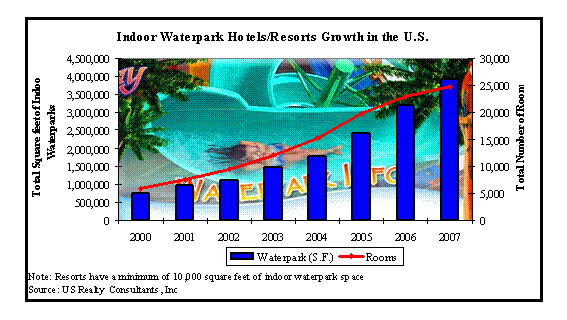 Since a typical guest of an indoor waterpark resort drives from two to three hours distance, the struggling airline industry does not make as significant an impact on indoor waterpark resorts as compared to the traditional resorts. However, the economy plays a significant role in this business. Many waterpark operators have concerned regarding the current state of the economy, as well as with high gas prices. The following table depicts indoor waterpark hotels and resorts that opened in 2007, most of which are located in the Midwest. 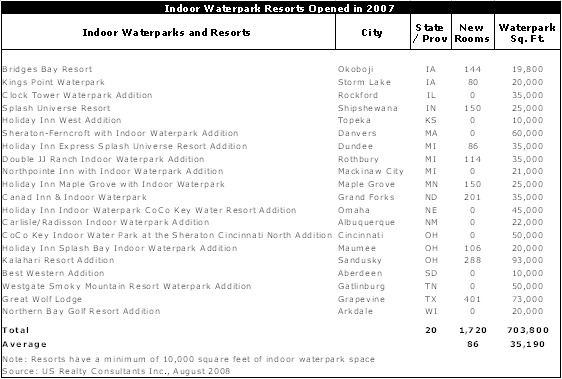
. The following table presents indoor waterpark hotels and resorts under
construction or that opened in 2008. It is noted that not all properties
under construction will open in 2008.
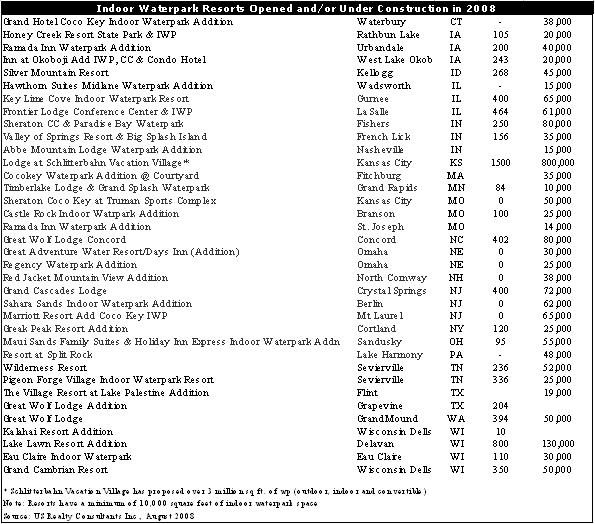 Norms Have Been Changing Changes in locations, types (mixed-use), sizes, orientation and features at indoor waterpark hotels and resorts have occurred in recent years, as further detailed in this analysis. Location: Expanding Previously, the norm was to develop indoor waterpark hotels and resorts in the Midwest or colder regions; however, more new developments are occurring in other parts of the nation as well. For example, the Great Wolf Resorts opened a 73,000 square-foot indoor waterpark space with additional outdoor waterpark features and 401 rooms in Grapevine, Texas in December 2007. Its additional 204 hotel rooms will open in December 2008. The Great Wolf Resorts is opening another 402-room property with approximately 80,000 square feet of indoor waterpark space and other amenities by summer 2009 in Concord, North Carolina. The Village Resort in Flint Texas added 19,000 square feet of indoor waterpark in 2008. We are currently tracking over 32 hotels and resorts totaling 1,825,000 square feet of indoor waterpark space and 7,800 rooms that are either under construction or proposed in the South Central and Atlantic regions of the United States. Similarly, we have been tracking 46 hotels and resorts totaling 2,442,000 square feet of indoor waterpark space and 13,400 rooms that are either under construction or proposed in the Western and Mountain regions of the United States. While locational diversification is occurring, the Midwest still leads the market by far with over 95 hotels and resorts under construction or proposed with over 22,000 rooms and 3,980,000 square feet of indoor waterpark space. Types: More Mixed-Use Developments Indoor waterparks are being developed at mixed-use developments ranging from retail malls, residential developments, to other commercial developments. A $750 million trend-setting retail entertainment destination comprised of multiple shopping, dining, lodging, and entertainment venues connected by a �Transportainment River System (transportation plus sport plus entertainment) is under development phase in Kansas City, Kansas. This 376-acre project will include one of the largest indoor/outdoor (convertible) waterparks with miles of interconnected rivers and attractions. The project will also include 1,800 accommodations including a full-service hotel, waterfront cabins, condominiums, and the unique elevated tree pods - all integrated within waterpark attractions. The resort is anticipated to be completed by fall of 2011. Wilderness Resort in Wisconsin Dells has added numerous leisure amenities over the years. It has become one of the largest indoor waterpark resorts in the country. Amenities at this resort include indoor waterpark, outdoor waterpark, hotel, restaurants, meeting space, condominiums, cabins, villas, golf course, spa, and snow tubing. Many indoor waterpark resorts added condominium units in the early part of this decade when the condominium market was thriving. Many of these waterpark resorts successfully sold their proposed condominium units during pre-construction. However, with the housing market bubble, condominium developments have slowed significantly. Conversely, several existing timeshare resorts have recently added indoor waterparks. Several of them have reported increases in the number of timeshare sales and prices with the addition of the indoor waterparks. A few examples of the timeshare resorts with indoor waterpark space include the Massanutten Resort in Harrisonburg, Virginia; Split Rock Resort Golf Club in Lake Harmony, Pennsylvania; Westgate Smoky Mountain Resort in Gatlinburg, Tennessee; and The Villages Resort in Flint, Texas. Size of Waterparks: Mixed Results As presented in the table below, the overall average size of indoor
waterpark space increased from 2004 through 2006, but declined in 2007.
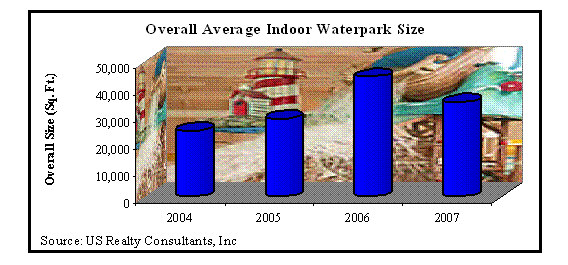
. Many existing waterpark resorts, especially in the area where competition is tough, are adding more waterparks and related amenities to gain a competitive edge. Our research also indicates that the typical waterpark guest desires to go to comparatively larger facilities with additional amenities. This has compelled many developers, especially in a competitive market, to build larger waterparks. A good example of the trend is seen in the �capital� of indoor waterparks-Wisconsin Dells, Wisconsin. The Wilderness Resort Wisconsin Dells currently boasts over 240,000 square feet of indoor waterpark space and an additional 135,000 square feet of outdoor waterpark space. The most recent addition at this property was the 65,000 square foot Wildwater Dome indoor waterpark in April 2006. Chula Vista Resort Wisconsin Dells added approximately 80,000 square feet of indoor waterpark space to its existing 30,000 square feet. Its addition also included meeting space, condominiums and other amenities. The Great Wolf Lodge Wisconsin Dells added 38,000 square feet of indoor waterpark space in 2006 to its existing 40,000 square foot indoor waterpark, to provide 78,000 square feet of indoor waterpark space. Currently, Great Wolf Lodge is the largest indoor waterpark owner/operator in the nation with 10 existing indoor waterpark resorts, nine of which are located in the U.S., and one in Canada. It currently has one indoor waterpark resort under construction in Concord, North Carolina and a couple proposed in other parts of the country. The Great Wolf Lodge originally developed indoor waterparks ranging from 30,000 square feet to 45,000 square feet, but has since started building in a range from 50,000 square feet to 100,000 square feet. When Kalahari Resort Wisconsin Dells opened in 2000, it included 272 rooms and 50,000 square feet of indoor waterpark space. Several subsequent expansions resulted in a facility that now boasts 752 rooms and 125,000 square feet of indoor waterpark space. Similarly, the Kalahari Resort Sandusky doubled its size to 884 rooms, 173,000 square feet of indoor waterpark space and 100,000 square feet of meeting space in 2007. It originally opened in 2005. Orientation: Independent to Branded Properties In the early portion of the decade, most of the indoor waterpark properties
were primarily confined in the Wisconsin Dells and were independently operated.
However, now many branded indoor waterpark hotels and resorts are opening
throughout the country.
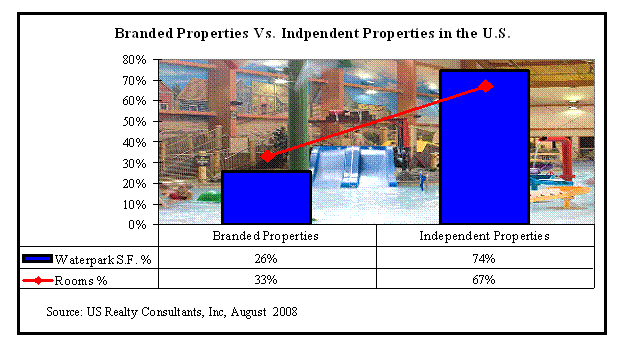 Our research shows national brands now comprise 33% of the rooms and 26% of the indoor waterpark space of all available indoor waterpark hotels and resorts. Branded properties have more rooms per available square foot of indoor waterpark space, while independent properties have more square feet of indoor waterpark space per available room. Typically, independent properties need larger indoor waterpark space and more amenities to justify their developments as they lack the national marketing and reservation systems, and loyalty programs offered at branded properties. A new trend that was specifically visible in 2007 was the addition of indoor waterpark space at existing branded properties. Of the nine branded properties listed in the prior table of additions in 2007, eight were existing properties that added indoor waterpark space. Several managers indicated that the addition of the indoor waterpark diversified their amenities, helped their penetration in the leisure demand segment, and provided them with a competitive advantage over the non-indoor waterpark properties. Some of the prominent brands include Holiday Inn, Sheraton, and Best Western. Just a few years ago, brands such as Sheraton and Marriott did not introduce indoor waterparks as it often was considered troublesome physically separating commercial guests from leisure guests. That is no longer the case. There are six Sheraton hotels with indoor waterpark space, and a full-service Marriott in Mt. Laurel, New Jersey is adding approximately 65,000 square feet of indoor waterpark space by November 2008. Waterpark Features: Adding More Waterpark Features Developers have continued to add more waterpark amenities at their properties. Until recently, indoor waterparks typically included features such as body slides, tube slides, kiddie rides, lazy rivers and swimming pools. In addition to these features, several newer indoor waterparks contain wave pools, hurricane & tornado rides, family raft rides, surfriders, and flow riders to name a few. Other unique features include laser tag, miniature golf course, themed-game, convertible roof system and texlon roof system. Many newer waterparks now use texlon roof systems which are clear and allow sunlight to penetrate the waterpark area. Some waterparks are adding sports complexes that could house various leagues including soccer, volleyball, tennis, bowling alleys and other sports. Bottom Line Based on numerous studies that US Realty Consultants, Inc. has performed,
net operating revenue for indoor waterpark resorts is typically between
15% and 35% of total revenue depending on size, location, and management.
Hotels with larger indoor waterparks typically have their net operating
incomes in the upper end of this range. Net operating income percentages
of similar non-waterpark full-service hotels are typically in the low 20%
range. The more impressive net income on indoor waterpark resorts also
comes with comparatively higher investments than the similar non-indoor
waterpark hotels or resorts. Typically, indoor waterpark hotels and resorts
achieve considerably higher occupancies and average daily rates than other
hotels without indoor waterparks. We have seen occupancy of indoor waterpark
hotel and resorts ranging from 5% to 30% higher than non-waterpark hotels,
and average daily rates ranging from $20 to $150 higher. With these spreads,
indoor waterpark hotels and resorts are anticipated to continue to grow
in the coming years. Mixed-use developments with the inclusions of indoor
waterparks are expected to emerge at a higher rate in ensuing years.
Rajesh Shah is an associate at US Realty Consultants, Inc., (USRC). He is a 2004 graduate of Hotel Administration at Cornell University. He previously worked for various hospitality companies including Westin, Sheraton and Hyatt. He can be reached at 614-221-9494 (ext. 136) or at [email protected] USRC is a national hospitality consulting and real estate valuation firm with offices in Columbus, Chicago, Cincinnati and West Palm Beach. We have performed more than 2,500 hotel and 100 indoor waterpark market feasibility and appraisals in the United States, Canada, Mexico and the Caribbean in the last 10 years. USRC specializes in the hospitality industry including hotels, resorts, indoor waterparks, outdoor waterparks, timeshares, condominiums, ski resorts, golf resorts, mixed-use developments, and other income producing properties |
| Contact:
Jeffrey H. Walker, MAI, CHME
|
|
|